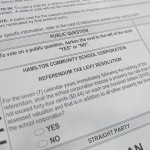Schools On The Ballot: Ft. Wayne And New Prairie

Ten school-related measures will appear on local ballots May 5. (Photo Credit: Jessica Whittle Photography/Flickr)
All week we are taking a closer look at the ten school referenda that will appear on ballots around the state May 3. A referendum asks voters in a particular area to choose whether to increase their property taxes to fund schools. We will follow all ten referenda and post results as they come in the night of May 3.
There are two types of school referendum a school district may put on a ballot– one that raises taxes to help with construction and renovation projects, or one that raises taxes to help the district’s general fund.
Ft. Wayne Community Schools and New Prairie United School Corporation are both asking voters to pass a construction referendum.
New Prairie United School Corporation
New Prairie United School Corporation in LaPorte and St. Joseph counties is looking to raise $42 million dollars to renovate and add to many of the district’s schools.
Superintendent Paul White says after property tax caps went into place in 2012, the fund to complete construction projects like this dramatically decreased. Once the caps went into place, the district has access to $3 million a year for construction projects, and White says they use all of that to just maintain current buildings.
The $42 million budget the district hopes to get after this referendum would help create new buildings and give major updates to existing schools.
A major project the district would like to complete with the money is build up the college preparatory program at the high school.
“We want to really build and cultivate a vocational wing of the high school to support programs we have in place already that we want to better support and we have some programs we want to add.”
White says they want to add Project Lead The Way, vocational agriculture, animal science and biomedical programs. Those types of programs require specific classrooms and labs that will be added to the high school.
The construction costs would also cover adding secure entries to some elementary schools and putting new roofs and boilers in a few schools.
White says updating the energy infrastructure costs money now but will save money for the taxpayers in the long term.
“Energy experts have calculated that we are spending about $150,000 district wide on energy inefficiency,” he says. “We would start saving the taxpayers [money] if we did this and put in more modern, energy efficient equipment.”
District officials and a political action committee created by community members in favor of the tax increase have spent the last few months educating the community about the details of the referendum.
White says one of the more confusing parts of the language on the ballot has to do with the rate hike itself. The actual rate increase, that will get the district the $42 million, is less than the number on the ballot. That’s because there’s already an increase in place to pay off the debt of a middle school in the district. For a few years taxpayers would fund both of those projects but in seven years, once the middle school is paid off, the rate will drop.
White says all the outreach they have done in the community makes him hopeful it will pass.
“We’ve been working really hard to engage with the community and it looks favorable. We have members of the community who have concerns or have voiced that they are against the project, but we have what appears to be more residents that are for it.”
Ft. Wayne Community Schools
The situation with Ft. Wayne Community Schools’ construction referendum is different from New Prairie. Rather than raise taxes to complete a new construction project, the district is asking voters to continue paying an increased property tax rate for a multiyear project to renovate all of the district’s schools. That project comes with a $130 million price tag.
Voters first approved a referendum in 2012 so the district could begin a two phase process to renovate the district’s schools. If the referendum on the May 3 ballot passes, phase two of this project may begin.
Chief Financial Officer for the district Kathy Friend says the schools renovated during Phase one were the ten neediest schools in the district. A lot of these schools got huge renovations. Friend says phase two will do smaller renovations on 42 schools.
“In Phase one we gained over $200,000 in energy efficiency in a year because of having better, more efficient [heating and cooling] systems, windows and all of that,” Friend says.
The second phase will put new roofs on schools, update heating and cooling systems in other schools and add new parent drop off lanes at certain schools. It will also update lighting and security systems at some schools.
Phase one came in under budget by $2 million, and Friend says this probably helps contribute to the positive feedback she’s getting from community members about this referendum. She says the referendum has received endorsements from many community groups, but even if it doesn’t pass, she says the district needs this money to improve the schools.
“We would want to come back to the taxpayers soon after,” Friend says. “I know we have to wait a year but we would come back again and try to get this done. That will just delay progress and we would like to get going to get these things taken care of.”
